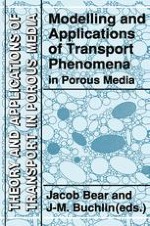Transport phenomenain porous media are encounteredin various disciplines, e. g. , civil engineering, chemical engineering, reservoir engineering, agricul tural engineering and soil science. In these disciplines, problems are en countered in which various extensive quantities, e. g. , mass and heat, are transported through a porous material domain. Often, the void space of the porous material contains two or three fluid phases, and the various ex tensive quantities are transported simultaneously through the multiphase system. In all these disciplines, decisions related to a system's development and its operation have to be made. To do so a tool is needed that will pro vide a forecast of the system's response to the implementation of proposed decisions. This response is expressed in the form of spatial and temporal distributions of the state variables that describe the system's behavior. Ex amples of such state variables are pressure, stress, strain, density, velocity, solute concentration, temperature, etc. , for each phase in the system, The tool that enables the required predictions is the model. A model may be defined as a simplified version of the real porous medium system and the transport phenomena that occur in it. Because the model is a sim plified version of the real system, no unique model exists for a given porous medium system. Different sets of simplifying assumptions, each suitable for a particular task, will result in different models.
